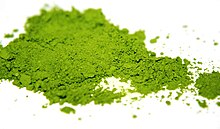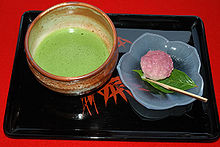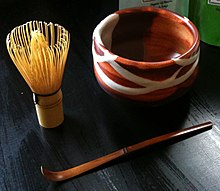 | ||
| What is that GREEN POWDER? It's not something the HULK puts on his face. It's GREEN MATCHA TEA! |
Why Matcha Tea?
Matcha is stone ground tea leaves. When you drink matcha tea, you ingest the whole leaf and receive 100% of the nutrients of the tea. One serving of matcha green tea is the nutritional equivalent of ten cups of regular brewed green tea in a tea bag.
Matcha is new in the United States and still difficult to find in grocery stores. However, it is gaining recognition in popular coffee shops and smoothie bars which offer green tea lattes and matcha shots. Many customers are looking matcha to make these addictive and expensive beverages at home.
Matcha
From Wikipedia, the free encyclopedia
 |
|
| Type: | Green |
|
|
|
| Other names: | 抹茶, "fine powder tea" |
| Origin: | Japan |
|
|
|
| Quick description: | Stone ground Japanese green tea |
|
|
|
Blends of matcha are given poetic names called chamei ("tea names") either by the producing plantation, shop or creator of the blend, or by the grand master of a particular tea tradition. When a blend is named by the grand master of some tea ceremony lineage, it becomes known as the master's konomi, or favored blend.
Contents |
History
In Tang Dynasty China (618–907), tea leaves were steamed and formed into tea bricks for storage and trade. The tea was prepared by roasting and pulverizing the tea, and decocting the resulting tea powder in hot water, adding salt.[2] In the Song Dynasty (960–1279), the method of making powdered tea from steam-prepared dried tea leaves, and preparing the beverage by whipping the tea powder and hot water together in a bowl became popular.[3] Preparation and consumption of powdered tea was formed into a ritual by Zen (Chan) Buddhists. The earliest Chan monastic code in existence, entitled Chanyuan qinggui (禪苑清規, Rules of Purity for the Chan Monastery, 1103), describes in detail the etiquette for tea ceremonies.[3][4]Zen Buddhism and the Chinese methods of preparing powdered tea were brought to Japan in 1191 by the monk Eisai. Powdered tea is no longer popular in China, but in Japan it continued to be an important item at Zen monasteries, and became highly appreciated by others in the upper echelons of society during the 14th through 16th centuries.
Production
Matcha is made from shade-grown tea leaves also used to make gyokuro. The preparation of matcha starts several weeks before harvest up to 20 days, when the tea bushes are covered to prevent direct sunlight.[5] This slows down growth, turns the leaves a darker shade of green and causes the production of amino acids. Only the finest tea buds are hand picked. After harvesting, if the leaves are rolled out before drying as usual, the result will be gyokuro (jade dew) tea. However, if the leaves are laid out flat to dry, they will crumble somewhat and become known as tencha (碾茶). Tencha can then be de-veined, de-stemmed, and stone ground to the fine, bright green, talc-like powder known as matcha.[6]It can take up to one hour to grind 30 grams of matcha.[citation needed]
Note that only ground tencha qualifies as matcha, and other powdered green teas, such as powdered sencha, are known as konacha (粉茶, lit. "powder tea").
The flavour of matcha is dominated by its amino acids.[citation needed] The highest grades of matcha have more intense sweetness and deeper flavour than the standard or coarser grades of tea harvested later in the year.[citation needed]
Grades
| This section does not cite any references or sources. (November 2011) |
Location on the tea bush
Where leaves destined for tencha are picked on the tea (Camellia sinensis) bush is vital.The very top should have developing leaves that are soft and supple. This gives a finer texture to higher grades of matcha. More developed leaves are harder, giving lower grades a sandy texture. The better flavour is a result of the plant sending the majority of its nutrients to the growing leaves.
Treatment before processing
Tencha leaves are traditionally dried outside in the shade and are never exposed to direct sunlight. However drying has mostly moved indoors. Quality matcha is vibrantly green also as a result of this treatment.Stone grinding
Without the right equipment and technique, matcha can become "burnt" and suffer degraded quality. Typically in Japan matcha is stone ground to a fine powder through the use of specially designed granite stone mills.[7]Oxidation
Oxidation is also a factor in determining grade. Matcha exposed to oxygen can easily become compromised. Oxidized matcha has a distinctive hay-like smell and a dull brownish green colour.Traditional preparation
There are two main ways of preparing matcha: thick (濃茶 koicha) and thin (薄茶 usucha).Prior to use, the matcha is often forced through a sieve in order to break up clumps. There are special sieves available for this purpose, which are usually stainless steel and combine a fine wire mesh sieve and a temporary storage container. A special wooden spatula is used to force the tea through the sieve, or a small, smooth stone may be placed on top of the sieve and the device shaken gently.
If the sieved matcha is to be served at a Japanese tea ceremony it will then be placed into a small tea caddy known as a chaki. Otherwise, it can be scooped directly from the sieve into a tea bowl.
A small amount of matcha is placed into the bowl, traditionally using a bamboo scoop called a chashaku, then a modicum of hot (not boiling: 70–85°C or 158–185°F[8]) water is added. The mixture is then whisked to a uniform consistency, using a bamboo whisk known as a chasen. There must be no lumps left in the liquid, and no ground tea should remain on the sides of the bowl. Because matcha can be bitter, it is traditionally served with a small wagashi sweet[9] (intended to be consumed before drinking), and without added milk or sugar. It is usually considered that 40 g of matcha will provide for 20 bowls of usucha or 10 bowls of koicha:[10]
Usucha, or thin tea, is prepared with approximately 1.75 grams[11] (amounting to 1.5 heaping chashaku scoop, or about half a teaspoon) of matcha and approximately 75 ml (2.5 oz) of hot water per serving, which can be whisked to produce froth or not, according to the drinker's preference (or to the traditions of the particular school of tea). Usucha creates a lighter and slightly more bitter tea.
Koicha, or thick tea, requires significantly more matcha (usually about doubling the powder and halving the water): approximately 3.75 grams[12] (amounting to 3 heaping chashaku scoops, or about one teaspoon) of matcha and approximately 40 ml (1.3 oz) of hot water per serving, or as many as six teaspoons to 3/4 cup of water. Because the resulting mixture is significantly thicker (about like liquid honey), blending it requires a slower, stirring motion which does not produce foam. Koicha is normally made with more expensive matcha from older tea trees (exceeding thirty years) and thus actually produces a milder and sweeter tea than usucha; it is served almost exclusively as part of Japanese tea ceremonies.
Other uses
It is used in castella, manjū, and monaka; as a topping for kakigori; mixed with milk and sugar as a drink; and mixed with salt and used to flavour tempura in a mixture known as matcha-jio. It is also used as flavouring in many Western-style chocolates, candy, and desserts, such as cakes and pastries (including Swiss rolls and cheesecake), cookies, pudding, mousse, and green tea ice cream. The Japanese snack Pocky has a matcha-flavoured version. Matcha may also be mixed into other forms of tea. For example it is added to genmaicha to form what is called matcha-iri genmaicha (literally roasted brown rice and green tea with added matcha).The use of matcha in modern drinks has also spread to North American cafés, such as Starbucks which introduced "Green Tea Lattes" and other matcha flavored drinks after matcha became successful in their Japan store locations. As in Japan, it has become integrated into lattes, iced drinks, milkshakes, and smoothies. A number of cafes have introduced lattes and iced drinks using matcha powder. It has also been incorporated into alcoholic beverages such as liqueurs.
Basic matcha teaware
The equipment required for the making of matcha are:- Tea bowl (茶碗, chawan)
- large enough to whisk the fine powder tea around 120 millilitres (4.06 fl oz)
- Tea whisk (茶筅, chasen)
- a bamboo whisk with fine bristles to whisk or whip the tea foam
- Tea spoon (茶杓, chashaku)
- (also called tea scoop) a bamboo spoon to measure the powder tea into the tea bowl. Not the same as a Western teaspoon.
- Tea caddy (棗, natsume)
- container for the matcha powder tea
- Tea cloth (茶巾, chakin)
- small cotton cloth for cleaning tea ware during the tea ceremony
Health benefits
Matcha can now be found in numerous health food products ranging from cereal to energy bars. In 2003, researchers from the University of Colorado found that the concentration of the antioxidant EGCG available from drinking matcha is at least three times greater than the amount of EGCG available from other commercially available green teas.[13] Matcha is also said to boost metabolism[citation needed] and help reduce cholesterol levels when it is drunk regularly.[citation needed] The aforementioned health benefits of matcha green tea can largely be attributed to the fact that the whole tea leaf is ingested, as opposed to just the steeped water in the case of 'bagged' green teas. This means that it delivers a much higher potency of catechins, chlorophyll, and antioxidants.[14] By weight, matcha contains more antioxidants than blueberries, wolfberries, pomegranates, orange juice and spinach.[15]There is evidence from clinical studies that suggests that theanine, when consumed by drinking Japanese green teas,[16] may help to reduce or moderate mental stress responses.[17]
Gallery
|
|
This section looks like an image gallery. |
-
Matcha dango
Why Matcha Source?
Matcha Source teas are available in four price points and one blend, Sugar Destroyer Matcha with Gymnema. Our informative and easy to use website offers detailed information on matcha's renown health benefits and methods of preparation.
Expect best quality teas and excellent customer service from Matcha Source.
Read and "LIKE" https://www.facebook.com/matchasource
Some of their great recipes!
Green Tea Smoothie - Simple
A simple and nutritious breakfast food, made with matcha tea and yogurt.
- 1/2 cup yogurt
- 2 tbsp honey or sugar
- 1/2 cup ice cubes
- 1 tsp ingredient grade matcha
Green Tea Smoothie - Juicy
This is surprising delicious and tastes much like a sherbet.
- 1/2 cup orange juice
- 1/2 cup soy or almond milk
- 1 tsp ingredient grade matcha
Green Tea Smoothie - Fruity
Boost your daily antioxidants with matcha and assorted berries.
- 1/4 cup blueberries, raspberries or black berries - washed, frozen are OK
- 1/2 cup yogurt
- 1/2 cup ice
- 1 tsp ingredient grade matcha
Green Tea Smoothie - with Protein Powder
Popular with body builders and athletes.
- your choice of protein powder
- 1/2 banana
- 1/2 cup nonfat milk or yogurt
- 1-2 tsp ingredient grade matcha
Also: http://en.wikipedia.org/wiki/Matcha








1 comment:
Never heard of it but as I love green tea, I'd now be inspired to try it. Found you through Sits FB page!
Post a Comment